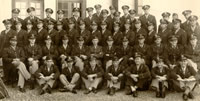Deployment In North Africa and Italy
Operation Torch, Casablanca, Algiers, Sicily, and Salerno
The Provisional General Hospital in Casablanca
On November 1, 1942, the men from the 8th Evacuation Hospital were on the U.S.S. Santa Paula. The ship set sail the next day before dawn without the nurses due to concern for their safety, given the possibility of disembarking in a combat zone. The Santa Paula was part of a huge convoy of 35 to 40 ships, including a battleship, a cruiser, an aircraft carrier, and an assortment of destroyers, freighters, and troop transports. Unknown to them at the time, the men from the University unit were part of Operation Torch, the Anglo-American invasion of North Africa.
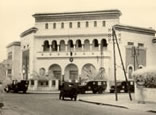
Italian Consulate
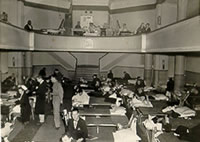
Ward inside the Italian Consulate
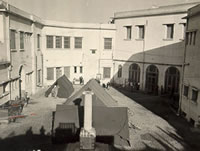
Italian Consulate Courtyard Tents
The Santa Paula was built in 1932 and had been a luxury cruise ship with a capacity of 228 passengers. After conversion it carried approximately 3,000 troops. Single or double occupancy cabins were modified to hold six to nine officers, and the enlisted men slept in bunks stacked four to six high, built so close together that the men had difficulty even turning over. On-board the men passed time by reading, playing cards, talking, and practicing fire and general alarm drills. On November 20th, after an uneventful cruise, the 8th Evacuation Hospital unit went ashore at Casablanca and proceeded to the Italian Consulate to set up a provisional general hospital.
Two days after landing the unit was treating patients, although it took weeks to make the building truly functional for hospital purposes. The U. S. Army Engineers drew up the plan for the renovation and provided the materials, but were unable to actually carry out the work due to other responsibilities. Major Paul Winthrop, an oral surgeon from Delaware and a World War I veteran, was put in charge of turning the Consulate into a 400-bed general hospital. Arab contractors replaced sewer and water lines, rewired the building, removed walls, and built an operating room.
In addition to caring for patients, the hospital staff was responsible for determining whether certain patients would be returned to duty with their units or evacuated to the United States. An annex for convalescent patients and ten-ward tents for a venereal disease stockade were operated by other groups, but under the administration and professional supervision of the 8th Evacuation Hospital.
The new year of 1943 was ushered in by the unit’s first air raid:
No one seemed to know what to do, but nearly everyone was doing what he ought not to have done. Some patients ran around on the roof for a better view of the spectacle, and others congregated in the courtyard and in front of windows; they yelled encouragement to the anti-aircraft crews and shouted insults at the Nazi bombers. The frenzied activity reminded one of a crowd at a traditional American Football game. The fact that there was danger seemed to have entered no one’s mind…tents and doors were struck, and in the morning bushels of shrapnel were picked up from the roof of the hospital and the courtyard. The disorganization at the hospital during the raid pointed out a serious defect in the unit’s training and preparedness. This defect was quickly remedied; when the next alert came several nights later, the hospital was completely blacked out, and the personnel moved all patients to the ground floor or basement, where they remained until the “all clear” sounded (Leavell, p. 57).
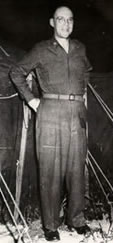
Colonel John W. McKoan
Lieutenant Colonel Putnam was forced to give up his command of the 8th Evac when he suffered a perforated ulcer in January. Lieutenant Colonel E. Cato Drash became acting commanding officer until Colonel John W. McKoan, a graduate of the Harvard University Medical School, arrived. Colonel McKoan oversaw the closing of the hospital at the Italian Consulate a little less than four months after its establishment. In that time there were nearly 4200 admissions. Eighty-four percent of the admissions were due to disease, fifteen percent were injuries, and about one percent were battle casualties from the initial invasion of French Morocco and the New Year’s Eve air raid. In addition to inpatients, thousands of outpatients were treated in outpatient departments and the dental clinic.
Closing Operations in North Africa
On March 14th the 8th Evacuation Hospital moved to a new location on Anfa Hill and four days later began to function as a convalescent hospital. On the same day First Lieutenant Ruth Beery and 51 nurses arrived in Casablanca on the transport John Ericcson. While awaiting approval to sail to Africa, the nurses had been working at Halloran General Hospital on Staten Island, New York. They cared for servicemen who had been wounded in the North African invasion, including some who had been treated at the hospital staffed by the 8th Evacuation unit in Casablanca.
On May 8, 1943, the Tunisia campaign came to a successful conclusion exactly six months after the Allied landings in North Africa. By early June the hospital was dismantled and parked while the staff awaited orders for the next move. During its two months of service as a convalescent hospital, the staff cared for nearly 1460 inpatients. Forty-eight percent were classified as diseased, thirty percent as injured, and twenty-two percent as wounded.

Anfa Hill Convalescent Hospital

Cap Matifou, Algiers
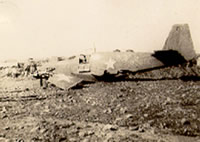
Downed Plane near Salerno, Italy
Following the defeat of the Axis forces in North Africa, the invasion of Sicily was undertaken. This successful attack ended Italian participation in the war and cleared the Mediterranean for the Allies. Forty-four men from the 8th Evacuation Hospital provided medical care to casualties aboard landing ships as they were ferried back to North Africa for treatment. The rest of the unit moved to a bivouac area on the Mediterranean coast at Cap Matifou, Algiers, for six weeks while awaiting the next orders.
Finally on September 5, 1943, the 8th Evacuation Hospital departed from Cap Matifou and by truck, train, and ship traveled to Salerno, Italy, arriving twelve days after the amphibious attack against the Italian mainland. The unit was taken by landing barges to the beach and then followed white tape marking a safe path through mine fields, dotted with tank traps and foxholes. About midnight they reached their bivouac area, which had evidently been the site of a battalion aid station. That first night in Italy the unit slept on the ground amidst slit trenches, foxholes, used bandages, K-ration boxes, and a downed plane (shown at right). The next morning it was announced that all the hospital equipment had been lost when the William W. Gerhard exploded after being torpedoed off the coast of Italy. Many in the 8th Evacuation Hospital feared they would be disbanded and sent to other units since it would be difficult to re-equip a 750-bed hospital in a combat area quickly. Colonel McKoan fought to keep the unit together, and the members quickly procured ward tents, a telephone system, generator, and laboratory equipment.
